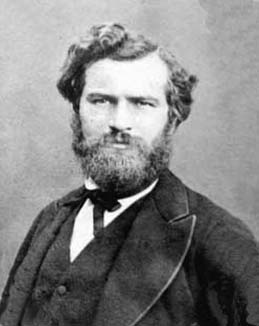Camille Jordan facts for kids
Quick facts for kids
Camille Jordan
|
|
|---|---|
 |
|
| Born | 5 January 1838 |
| Died | 22 January 1922 (aged 84) Paris
|
| Nationality | French |
| Alma mater | École polytechnique |
| Known for | Jordan curve theorem Jordan normal form Jordan matrix Jordan measure |
| Scientific career | |
| Fields | Mathematics |
| Academic advisors | Victor Puiseux and Joseph Alfred Serret |
Marie Ennemond Camille Jordan (born January 5, 1838 – died January 22, 1922) was a famous French mathematician. He is well-known for his important work in group theory and for his influential book, Cours d'analyse.
Contents
About Camille Jordan
Camille Jordan was born in Lyon, France. He studied at the École polytechnique, a famous engineering school. He first worked as an engineer. Later, he became a professor at the École polytechnique and the Collège de France. People knew him for using unique ways to write down math problems.
Jordan's Big Ideas in Math
Camille Jordan's name is used for many important ideas in mathematics. These ideas are still used by mathematicians today:
- The Jordan curve theorem: This is a rule in topology, which is a part of geometry. It helps us understand shapes and spaces. It's important for complex analysis, a type of math that deals with complex numbers.
- The Jordan normal form and the Jordan matrix: These are tools used in linear algebra. Linear algebra helps us solve systems of equations and understand transformations.
- Jordan measure (or Jordan content): This is a way to measure the "size" or "area" of shapes. It was used before a more modern way of measuring called measure theory was developed.
- The Jordan–Hölder theorem: This is a basic rule in group theory. Group theory studies sets of things with a special operation, like adding or multiplying numbers.
- Jordan's theorem on finite linear groups: This theorem is also about groups, specifically groups of transformations.
His Contributions to Mathematics
Jordan's work greatly helped make Galois theory popular. Galois theory helps us understand how to solve equations using groups. He also studied special groups called Mathieu groups. These were the first examples of sporadic groups, which are unique groups that don't fit into other categories.
In 1870, Jordan published his book Traité des substitutions. This book was about permutation groups, which deal with arranging things in different orders. For this book, he won the 1870 prix Poncelet, a special award. He was also asked to speak at the ICM in 1920.
Honors and Other Jordans
An asteroid called 25593 Camillejordan and a math institute in France, Institut Camille Jordan, are named after him.
It's important not to confuse Camille Jordan with other famous people named Jordan. He is not the same person as Wilhelm Jordan, who was a geodesist (someone who studies the Earth's shape). Wilhelm Jordan is known for something called Gauss–Jordan elimination. He is also not the same as the physicist Pascual Jordan, who is known for Jordan algebras.
See also
 In Spanish: Camille Jordan para niños
In Spanish: Camille Jordan para niños

